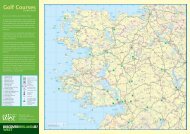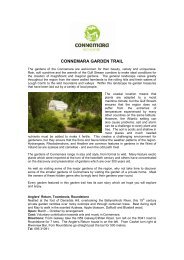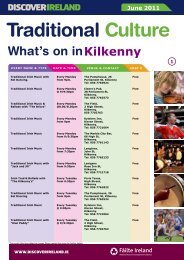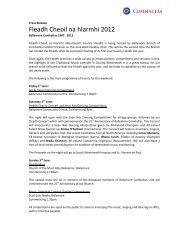Boyne Valley brochure [pdf, 8.03MB] - Discover Ireland
Boyne Valley brochure [pdf, 8.03MB] - Discover Ireland
Boyne Valley brochure [pdf, 8.03MB] - Discover Ireland
Create successful ePaper yourself
Turn your PDF publications into a flip-book with our unique Google optimized e-Paper software.
Drogheda<br />
Drogheda was an important Anglo-Norman<br />
settlement and one of the largest walled<br />
towns in Medieval <strong>Ireland</strong><br />
24 FOR MORE INFORMATION GO TO WWW.BOYNEVALLEYDRIVE.IE<br />
Drogheda derives its name from<br />
the Irish Droichead Átha meaning<br />
‘Bridge of the Ford’. It is the largest<br />
town in Co. Louth – <strong>Ireland</strong>’s<br />
smallest county – which is named<br />
after Lugh, the great god of the<br />
Celts. Although the origins of the<br />
settlement are obscure, the town<br />
certainly owes its development to<br />
the coming of the Anglo-Normans.<br />
Drogheda proper began as an Anglo-Norman<br />
port founded by Hugh de Lacy after whom the de<br />
Lacy Bridge in the town is named. Around 1180, it<br />
developed as two settlements on opposite banks of<br />
the <strong>Boyne</strong> estuary, downstream from the ford from<br />
which it gets it name. Drogheda was granted its charter<br />
in 1194. The Anglo-Normans made Drogheda one of<br />
their primary strongholds, completing the town walls in<br />
the mid 13th century. The walls enclosed and fortified<br />
an area of 43 hectares, north and south of the <strong>Boyne</strong>,<br />
making it one of the largest walled towns in medieval<br />
<strong>Ireland</strong>. Drogheda-in-Louth was the larger of the two<br />
towns with a walled area of 32 hectares. After<br />
years of conflict and rivalry, the two boroughs<br />
were conjoined as a single town in 1412, and<br />
in 1898 the southern portion of the town was<br />
transferred from Co. Meath to Co. Louth.<br />
St. Laurence’s Gate, which led to the Friary of St<br />
Laurence, is widely regarded as one of the finest<br />
of its kind in Europe. It consists of two lofty<br />
circular towers, connected together by<br />
a wall, in which there is an archway. It was<br />
originally known as the east gate but it was<br />
renamed in the 14th century because the street<br />
led to the Hospital of St. Laurence. Visitors can<br />
appreciate the spectacular dimensions of the<br />
medieval walls south of the gate at Featherbed<br />
Lane. Twice the walls and gates of Drogheda<br />
held strong against invasion, firstly when Edward<br />
Bruce attacked the town in 1317 and again in<br />
1642 when Sir Phelim O’Neill attempted to take<br />
Drogheda. In 1494 Parliament met at Drogheda<br />
and enacted the infamous Poynings’ Law which<br />
remained in force until 1801 when The Act of<br />
Union made it redundant. In 1649 Cromwell<br />
breached the walls and sacked the town,<br />
massacring 3,500 soldiers, civilians and clergy,<br />
and deporting captives as slaves to Barbados.<br />
Drogheda surrendered to King William after the<br />
Battle of the <strong>Boyne</strong> in 1690. Millmount Tower &<br />
Museum and St. Peter’s Church, housing the<br />
shrine of St Oliver Plunkett are also within<br />
the town.<br />
The Tholsel building on West Street (image<br />
p.24) was erected in 1770 on the site of the old<br />
mediaeval wooden Tholsel, it was for almost 130<br />
years the centre of<br />
municipal authority.<br />
The Tholsel has<br />
been for countless<br />
generations a local<br />
trysting place, and<br />
before the advent of<br />
radio and television,<br />
with their constant time checks, Drogheda’s<br />
clocks and watches were set by its dependable<br />
old time-piece. Sessions of the Irish Parliament<br />
were held regularly in the town, either at the<br />
Franciscan Friary now Highlanes Gallery or at the<br />
Tholsel of ‘Drogheda in Meath’. Poynings Law<br />
(which made the Irish Parliament subservient to<br />
the English Parliament) was enacted in 1494, in<br />
the Tholsel.<br />
Did you know? The <strong>Boyne</strong> Viaduct at Drogheda is<br />
<strong>Ireland</strong>’s greatest example of Victorian industrial<br />
architecture. The bridge, which carries the<br />
Dublin-Belfast railway line, was opened in 1855.<br />
St Patrick landed at the mouth of the river <strong>Boyne</strong>,<br />
near Drogheda, in 432AD when he arrived in<br />
<strong>Ireland</strong> to introduce Christianity.<br />
Contact Details:<br />
Drogheda Tourist Office<br />
The Tholsel,<br />
West Street<br />
Drogheda, Co. Louth<br />
T: +353 (0)41 9872843<br />
W: www.drogheda.ie<br />
E: droghedatouristoffice@gmail.com<br />
GPS: 54.039671, -6.185043<br />
Drogheda<br />
FOR OPENING TIMES AND ADMISSION DETAILS PLEASE SEE PULL OUT INSERT AT THE BACK 25


![Boyne Valley brochure [pdf, 8.03MB] - Discover Ireland](https://img.yumpu.com/13306944/26/500x640/boyne-valley-brochure-pdf-803mb-discover-ireland.jpg)














